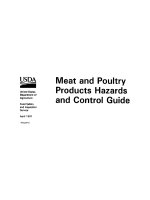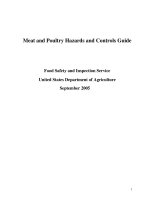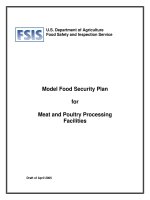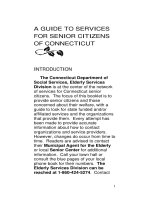A GUIDE TO FEDERAL FOOD LABELING REQUIREMENTS FOR MEAT AND POULTRY PRODUCTS potx
Bạn đang xem bản rút gọn của tài liệu. Xem và tải ngay bản đầy đủ của tài liệu tại đây (656.92 KB, 117 trang )
A GUIDE TO FEDERAL FOOD LABELING
REQUIREMENTS FOR MEAT AND POULTRY
PRODUCTS
Edited by
Post, R., Budak, C., Canavan, J., Duncan-Harrington, T., Jones, B. Jones,
S., Murphy-Jenkins, R., Myrick, T., Wheeler, M., White, P., Yoder, L.,
Kegley, M.
The Labeling and Consumer Protection Staff
Office of Policy, Program, and Employee Development
Food Safety and Inspection Service
U.S. DEPARTMENT OF AGRICULTURE
August, 2007
Work performed under contract by
Hogan & Hartson, LLP
Washington, DC
DISCLAIMER
This Guide is designed as a user-friendly introduction to the
basic food labeling requirements for meat and poultry products. It does
not represent, nor should it be relied upon as, an official or binding
statement by the Labeling and Consumer Protection Staff, LCPS), Office of
Policy, Program, and Employee Development (OPPED), of the Food Safety
and Inspection Service (FSIS) of the U.S. Department of Agriculture
(USDA). Users should consider changes in FSIS regulations and policies
arising after the Guide’s publication date.
* * *
The impetus for the Guide was to create a user-friendly,
comprehensive guide to assist food companies in the development of food labels
that comply with the array of requirements policies. While not a substitute for
careful review of the requirements referenced throughout, the Guide will
provide the reader with a useful tool to identify and understand those
requirements that shape the food label presented to consumers.
Building from the expertise and experience of the Labeling and
Consumer Protection Staff, OPPED, the Agency sought to utilize a contractor
who would offer an understanding of the rules in practice. The reader benefits
from the day-to-day learning’s of those who are involved in the review and
approval of labels and others who routinely assist companies in the application
of the labeling rules.
LCPS developed the scope and content of this Guide under a
contract with Hogan & Hartson, LLP, Washington, DC. The Agency recognizes
the contributions of the staff who served as editors and provided oversight in
the creation of the Guide: Robert C. Post, Ph.D. MEd., MSc., Catherine Budak,
Food Technologist, Jeffery Canavan, Food Technologist, Tawana Duncan-
Harrington, Program Analyst, Bill Jones, Chemist, Sally Jones, Senior
Technical Advisor, Rosalyn Murphy-Jenkins, Senior Technologist, Tammie
Myrick, Food Technologist, Mark Wheeler, Biological Scientist, Patricia White,
Nutritionist, and Lynn Yoder, Program Analyst, Marlene Kegley, Program
Analyst, served as contract coordinator.
The contributions of attorneys at Hogan & Hartson, LLP in drafting
the Guide are also acknowledged: Steven B. Steinborn, Ryan Shadrick-Wilson,
Lorrin H. Tuxbury, Robert O. Winters, and Elizabeth B. Fawell.
- 2 -
TABLE OF CONTENTS
Page
I. TIPS AND PITFALLS IN DESIGNING A FOOD LABEL 3
II. INTRODUCTION TO FOOD LABELING 4
A. The Federal Agencies and Their Statutory Authority to
Regulate Food Labeling 4
1. The United States Department of Agriculture’s
Food Safety and Inspection Service (FSIS) 4
2. The U.S. Food and Drug Administration (FDA) 6
3. FSIS and FDA: Distinct Approaches to Labeling
and Jurisdiction 7
4. The Federal Trade Commission (FTC) 11
B. Role of the States Validity of State and Local
Regulations that Affect the Food Label 13
III. FSIS LABELING – SURVEY OF BASIC PRINCIPLES 14
A. When Packaging Must Bear Required Labeling 14
B. The Prior Label Approval Process 16
1. Treatment of Retail Labels 18
2. Establishment Responsibilities 18
3. “Temporary” Label Approvals 19
4. Generic Label Approvals 20
5. Generic Modifications to Labels 21
C. Regulatory References – Resource Tools 22
IV. MANDATORY REQUIREMENTS INTRODUCTION 23
A. Principal Display Panel 24
B. Information Panel 25
V. PRODUCT NAME 26
A. Overview 26
1. Determining a Product’s Name 26
2. Placement and Prominence of Product Name 27
B. Standards of Identity 28
C. Common or Usual Name 29
D. Descriptive Names 29
E. Imitation Food Products 30
F. Geographic Origin 32
G. Country of Origin 35
VI. USDA INSPECTION LEGEND 35
VII. NET QUANTITY 37
A. Expression of Net Quantity Statement 38
B. Placement 39
C. Prominence 39
D. Exceptions and Other Special Requirements 40
VIII. INGREDIENTS STATEMENT LABELING 42
A. Overview: Basic Requirements 43
- i -
\\\DC - 087466/000001 - 1978434 v7
B. Artificial Flavorings, Colorings, and Chemical
Preservatives 45
1. Flavors – Specificity or Generic Identification 45
2. Color Additives 47
3. Chemical Preservatives 47
C. Incidental Additives 47
D. Labeling of Ingredients of Public Health Concern 49
IX. ADDRESS (SIGNATURE) LINE 50
X. HANDLING STATEMENTS 50
XI. SAFE HANDLING INSTRUCTIONS 51
XII. NUTRITION LABELING 53
A. Mandatory Nutrition Labeling - General Requirements 53
B. Full Format 56
C. Simplified Format 58
D. Tabular Format 59
E. Compliance Requirements Governing Nutrition Labeling 60
F. Reference Daily Intakes and Daily Reference Values 60
G. Exemptions from Mandatory Nutrition Labeling 62
H. Voluntary Nutrition Labeling 63
I. Serving Sizes 64
1. General Requirements 65
2. Common Household Measure 66
3. Reference Amounts Customarily Consumed (RACC)
Per Eating Occasion 67
4. Converting Reference Amounts Customarily
Consumed (RACCs) to Labeled Serving Sizes 69
a. Products in discrete units 69
b. Bulk products 70
c. Meal-type products 70
d. Exceptions 71
5. Servings Per Container 72
XIII.NUTRIENT CONTENT CLAIMS GENERALLY 73
A. General Requirements 73
1. Basic Principles Claims 73
2. Various General Requirements 75
3. Numeric and Percent Declarations 76
4. Relative Claims General Requirements 77
a. Appropriate Reference Food 77
b. Information that Must Accompany a Relative
Claim 77
5. Claims for Main Dish and Meal-Type Products are
Defined Separately 78
6. Exemptions 79
B. Specific Nutrient Content Claims 80
1. "High," “Good Source,” and “More” Claims 80
a. “High” Claims 80
- ii -
b. “Good Source” Claims 81
c. “More” Claims 81
2. “Light” and “Lite” Claims 81
3. "Sodium" and "Salt" Claims 82
a. “Sodium Free” Claims 82
b. “Very Low Sodium” Claims 83
c. “Low Sodium” Claims 83
d. “Reduced Sodium” Claims 84
e. “Salt” Claims 84
4. "Nutrient Content" Claims for Fat, Fatty Acids and
Cholesterol Content 85
a. "Fat Content" Claims 85
(1) “Fat Free” Claims 85
(2) “Low Fat” Claims 85
(3) “Reduced Fat” Claims 86
(4) “Percent Fat-Free” Claims 86
b. "Fatty Acid Content" Claims 87
(1) “Saturated Fat-Free” Claims 87
(2) “Low In Saturated Fat” Claims 88
(3) “Reduced Saturated Fat” Claims 88
c. "Cholesterol Content" Claims 89
(1) “Cholesterol Free” Claims 89
(2) “Low in Cholesterol” Claims 90
(3) “Reduced Cholesterol” Claims 90
d. “Lean” and “Extra Lean” Claims 91
5. "Fiber" Claims 92
6. “Healthy” Claims 92
7. Claims Related to Usefulness in Reducing or
Maintaining Body Weight 93
8. "Health" Claims 94
9. "Calorie Content" Claims 95
a. "Calorie Content" Claims 95
(1) “Calorie Free” Claims 95
(2) “Low Calorie” Claims 95
(3) “Reduced Calorie” Claims 96
b. "Sugar Content" Claims 96
(1) “Sugar Free” Claims 96
(2) “No Added Sugar” Claims 97
(3) “Reduced Sugar” Claims 998
APPENDIX A I. EGG PRODUCTS LABELING 99
a. Product Name 99
b. Manufacturer's Name 100
c. Official Identification 100
d. USDA Approval Number 101
e. Ingredients Statement 102
f. Net Weight Statement 102
- iii -
g. Nutrition Information 103
- iv -
PREFACE
The food label is important to food companies and consumers
alike. A company’s most direct (and sometimes only) way to communicate with
the consumer is via the food label. For consumers, the food label contains a
wealth of information, which allows for informed purchase decisions. The U.S.
Department of Agriculture (USDA), by statute, is charged with assuring that
meat and poultry products in interstate or foreign commerce, or that
substantially affect such commerce, are wholesome, not adulterated, and
properly marked, labeled and packaged.
1
Responsibility for the development
and application of the labeling requirements applicable to meat and poultry
products rests principally with USDA’s Food Safety and Inspection Service
(FSIS).
2
FSIS is charged with developing the labeling policy by which it is
determined if a meat or poultry product is misbranded or adulterated.
3
FSIS
food labeling regulations have evolved over the years, reflecting the evolution of
the food processing industry and consumer interest. Food manufacturers are
responsible for compliance with the FSIS labeling rules and adherence to the
process maintained by FSIS for the evaluation and approval of meat and
poultry product labels.
This Guide provides the basic information necessary to devise a
label for meat and poultry products and to understand the regulatory process
administered by FSIS. Answers to the most commonly asked questions are
incorporated. This Guide cannot possibly anticipate or address the large
number of issues that may arise in developing product labeling. The FSIS
- 1 -
website (www.fsis.usda.gov) is a good source of information, providing the
complete statutes, regulations, and policies. Included throughout the Guide
are cross references to the relevant sources, found primarily in the End Notes.
Some issues, particularly policy issues, will often require consultation with the
Labeling and Consumer Protection Staff (LCPS), OPPED, within FSIS.
Before delving into the details, the Guide begins with an overview
of the principal jurisdiction over the label, labeling and advertising of foods at
the federal level. The scope of USDA’s jurisdiction and statutory reach with
respect to covered and exempt meat and poultry products is detailed. The role
of the states in regulating food labeling is also addressed, along with an
explanation of the consistency required between state and federal law.
Section II provides an overview of the basic food labeling
requirements, including the prior label approval process, establishment
responsibilities, temporary label approvals, and other facets of the preapproval
process. Sections III through XII address in detail each of the up to eight
mandatory features that must be present on a meat or poultry label and other
mandatory and optional information that may be on such a label. Appended to
the Guide (Appendix A) is a discussion of the labeling requirements for egg
products, which are also administered by FSIS. Other useful excerpts of
labeling regulations and illustrations are included in various appendices as
noted throughout the Guide.
This Guide cannot substitute for a careful review of the underlying
statutes, regulations, policies, and guidance referenced throughout the Guide.
- 2 -
Consultation of the appropriate regulation, directive, and other guidance
document, as well as the FSIS website, provides valuable information on
devising an acceptable and compliant food label.
I.
TIPS AND PITFALLS IN DESIGNING A FOOD LABEL
• Begin label design with the mandatory labeling features required by FSIS
regulations. Deviation from these requirements to accommodate marketing
or other communication objectives does not ensure compliance.
• Ensure that placement and prominence requirements for each mandatory
feature of the food label are met.
• Review brand names, marketing copy, and all other information presented
on the label to determine if a regulated term is included.
• Make sure that foods subject to a standard of identity comply with the
applicable FSIS requirement.
• Make sure that ingredients/components are properly declared in the
ingredients statement.
• Novel or innovative products that trigger unique labeling issues should not
be submitted to be evaluated by FSIS staff as part of the sketch-approval
process. Instead, they should be addressed through direct contact with the
staff. Firms should build into the product launch schedule the time
necessary to allow for agency consideration of policy issues.
• Review ingredients statement for accuracy and completeness against
formulation information. Fully consult ingredient suppliers to obtain all
pertinent information as part of this review.
• Keep labeling files complete and current. Document generic approvals and
permitted modifications along with final approvals that must be retained by
the firm.
• Products that are not amenable and thus not subject to FSIS inspection
must still comply with applicable labeling rules. Similarly, products not
subject to prior approval (e.g., retail labeling) also must comply with
applicable labeling requirements.
• Fully consult the resources available at the FSIS website and always consult
the regulations, directives and other policies referenced in this Guide.
- 3 -
• If a label is not accurate, the label should not be used unless a temporary
approval is obtained.
II. INTRODUCTION TO FOOD LABELING
A. The Federal Agencies and Their Statutory Authority to Regulate
Food Labeling
The federal regulatory agencies that have jurisdiction over food
products derive their authority to govern the labeling of these products from
several principal statutes the Federal Meat Inspection Act (FMIA), the Poultry
Products Inspection Act (PPIA), the Egg Products Inspection Act (EPIA), the
Agricultural Marketing Act (AMA), the Federal Food, Drug and Cosmetic Act
(FFDCA), and the Fair Packaging and Labeling Act (FPLA). In addition, food
advertising – which in certain instances serves as an extension of food labeling
is subject to regulation by the Federal Trade Commission (FTC) under the
Federal Trade Commission Act, which prohibits false and deceptive advertising.
1. The United States Department of Agriculture’s Food Safety
and Inspection Service (FSIS)
FSIS has primary responsibility for the regulation of food labeling
for meat and poultry products under the FMIA
4
and the PPIA
5
and is also
authorized to regulate food labeling for exotic species of animals under the
Agricultural Marketing Act of 1946. The FMIA and PPIA define the food “label,”
in pertinent part, as “a display of written, printed, or graphic matter upon the
immediate container of any article,” and define “labeling” as “all labels and
other written, printed or graphic matter (1) upon any article or any of its
containers or wrappers, or (2) accompanying such article.”
6
USDA is
authorized under the FMIA and the PPIA to regulate marking, labeling, or
- 4 -
packaging of meat, poultry, or processed parts to prevent the use of any false
or misleading mark, label, or container. This broad definition makes FSIS
regulations applicable to product labels and materials that accompany a
product but are not attached to it, such as point-of purchase (POP) materials.
7
The scope of what constitutes a food label is discussed in further detail below.
The FMIA specifies the circumstances when products are
misbranded. The FMIA provides, in part, that any carcass, meat or meat
product is “misbranded” (1) if the product’s labeling is false or misleading in
any particular way; (2) if it is offered for sale under the name of another food;
(3) if it is an imitation of another food, unless it is labeled as such; (4) if its
container is misleading; (5) unless it bears a label with the name of the
manufacturer, distributor, and net quantity of contents; (6) if its labeling is not
prominent and conspicuous; (7) if it purports to be a food with a standard of
identity without conforming to the standard; (8) if it misrepresents itself as a
food with a standard of fill; (9) if it does not bear a common or usual name
(provided it is not covered by a standard of identity) and declare ingredients by
common or usual name; (10) if it purports to be a food for special dietary use
without conforming to FDA regulations on such products; (11) if it contains
artificial flavoring, artificial coloring, or chemical preservatives that are not
declared (with exceptions); and (12) if it fails to bear an inspection legend and
establishment number.
8
It is intended that these provisions apply within the
scope of the exceptions that may exist in the act. FSIS has similar authority
under the PPIA with regard to poultry products.
9
False or misleading labeling
- 5 -
can trigger a charge of misbranding pursuant to the wide range of labeling
requirements summarized in this Guide.
If a product is deemed misbranded, its manufacturer faces a wide
range of penalties that can be imposed by FSIS.
10
These include withholding
(rescinding) the use of labeling; product retention (prohibiting shipment);
product detention (prohibiting sale from anywhere in the chain of commerce);
request for product recall, press releases, and/or fines; and criminal
prosecution. In addition, the facility producing misbranded product faces the
possibility of inspection suspension or withdrawal.
11
2. The U.S. Food and Drug Administration (FDA)
FDA has primary statutory authority to establish labeling
requirements for foods and food ingredients under its purview pursuant to the
Federal Food, Drug and Cosmetic Act (“FFDCA”).
12
The FFDCA states, in a
fashion similar to the statutes enforced by USDA, that a food product is
misbranded, and is, therefore, in violation of the statute, if “its labeling is false
or misleading in any particular ”
13
Similar to the FSIS-enforced statutes, the FFDCA defines a “label”
as “a display of written, printed, or graphic matter upon the immediate
container of any article.”
14
Further, the FFDCA defines “labeling” as: “labels
and other written, printed, or graphic matter (1) upon any article or any of its
containers or wrappers, or (2) accompanying such article.”
15
This broad
definition makes FDA regulations applicable to product labels and materials
that accompany a product but are not attached to it. In addition, FDA has
- 6 -
regulatory authority under the Fair Packaging and Labeling Act (“FPLA”), a
companion statute to the FFDCA.
16
3. FSIS and FDA: Distinct Approaches to Labeling and
Jurisdiction
Prior approval by FSIS is required for all labels used for meat and
poultry products before those products may be marketed in interstate
commerce. There are distinct categories of prior approval, discussed below,
that dictate the precise manner in which a label is “approved.” FSIS derives its
authority for label approval from the provision in the Acts that states that no
food article “shall be sold or offered for sale by any person in commerce under
any name or other marking or labeling …but established trade names and
other marking and labeling and containers which are not false or misleading
and which are approved by the Secretary.”
17
USDA interprets this statutory
language as mandating the preapproval of all food labels before products that
bear the mark of inspection may be offered for sale.
Responsibility for USDA’s pre-market label approval process rests
with the FSIS Administrator.
18
Regulations and policies establish
requirements for the content and design of labeling to ensure that labeling is
truthful, accurate, and not misleading in order to prevent products from being
misbranded.
19
Annually, FSIS evaluates approximately 60,000 labels that are
sent to the Agency for evaluation and approval before they may be applied to
product destined for commerce. Many more new and revised labels are subject
to prior approval but are not submitted first for evaluation by the Agency,
provided manufacturers ensure that such final labels fall within the conditions
- 7 -
specified in the generic labeling regulations (as elaborated upon below). In
specified circumstances, labels that the Agency approved may be modified by
manufacturers without resubmitting them to FSIS for evaluation. However,
outside of these circumstances or instances where specific exceptions exist
(e.g., for random weight packages), only labeling that has been approved by
FSIS may be applied to meat and poultry products.
In contrast, FDA does not require prior label approval for food
products under its jurisdiction.
20
FDA has promulgated regulations
establishing requirements for all aspects of labeling and monitors labeling
compliance primarily through random post-marketing surveillance. FDA
reviews only a small portion of labels on food products falling under its
jurisdiction. FDA’s label review generally arises in connection with an informal
request for review by a manufacturer, a trade complaint by a competitor, a
consumer inquiry, or an FDA on-site inspection of a manufacturing facility.
Although FSIS has jurisdictional authority over food labeling for
products containing meat and poultry, the FMIA and the PPIA explicitly
authorize USDA (through FSIS) to exempt from its regulatory coverage food
products which contain meat or poultry “only in relatively small portion or
historically have not been considered by consumers as products of the meat
food industry ….”
21
By statute, the Secretary may (not, must) exempt product
applying either of the two stated criterion. Therefore, the statutes have long
been applied by the Agency as including all products containing meat or
poultry under FSIS jurisdiction (and, therefore, inspection). By default, all
- 8 -
other foods fall under the jurisdiction of FDA (and the statutes under which it
operates), including the products of exotic species of livestock and kinds of
poultry, (e.g., deer, elk, and pheasant.)
22
The determination of whether a product falls under the jurisdiction
of FSIS or FDA is referred to as “amenability.” Amenability decisions are based
on how a product is formulated, not the composition of the finished product.
USDA has set a rule that any food product containing the following is not
subject to the FMIA or PPIA (i.e., to FSIS inspection): (1) 3 percent or less raw
meat or less than 2 percent cooked meat, or (2) less than 2 percent cooked
poultry meat, less than 10 percent of cooked poultry skins, giblets, or fat,
separately, and less than 10 percent of cooked poultry skins, giblets, fat, and
meat in combination, (i.e., specific condition,) provided the poultry ingredients
were prepared under domestic or foreign inspection and the product is not
represented as a poultry product.
23
FSIS has formally adopted this rule with
regard to poultry, but has not done so for meat products. Nonetheless,
through decades-old policy, FSIS has applied a threshold level of meat that
makes meat food products amenable consistent with the poultry regulations.
Examples of meat products exempt from FSIS jurisdiction under one or the
other criteria specified in the FMIA and implementing regulations include
spaghetti sauces with less than 2 percent cooked meat, pork and beans, bagel
dogs, and gravy mixes. Because the regulations state that the Secretary may
exempt products, industry is strongly advised to seek clarification from FSIS in
cases where the status of jurisdiction is in question.
- 9 -
As noted, by regulation, FSIS has further defined certain products
as exempt from the definition of a “poultry product.”
24
These exemptions
include product that contains less than 10 percent of cooked poultry skins,
giblets, or fat separately and less than 10 percent of cooked poultry skins,
giblets, fat, and meat or “mechanically separated skins of poultry,” as defined,
and are not represented as a poultry product. Other exemptions include
product in an institutional pack and used as soup bases or flavorings
containing less than 15 percent cooked poultry meat and provided the specified
conditions (as noted above) of the regulation are met.
25
Bouillon cubes,
poultry broths, gravies, sauces, and flavorings also are exempt under the
specified conditions (as noted above).
26
These exemptions are null if the kind of poultry is listed in the
product name without appropriate qualification. Appropriate qualification is
using a term, such as “flavored,” that must be included as part of the product
name (e.g., “Chicken Flavored Noodle Soup”) to distinguish the food product as
different than a “poultry product” and, therefore, preserve the exemption.
Products that meet the exemption factors and conditions, and that are labeled
in this fashion, are subject to jurisdiction and regulation by FDA.
27
FSIS has concurrent jurisdiction with FDA over the setting of
standards of identity for food products.
28
The FMIA and PPIA state that
USDA’s standards for any meat and poultry food products may not be
inconsistent with standards established under the FFDCA.
29
- 10 -
Finally, FDA has authority to approve the safety of food ingredients
to be used in the production of food products, including meat or poultry
products.
30
The meat and poultry inspection laws explicitly permit only FDA-
sanctioned food ingredients (e.g., additives, GRAS substances, color additives)
to be used in the production of meat and poultry products, which FSIS also
must approve as suitable for use under prescribed conditions.
31
FSIS requirements regarding legal status as safe for use in food
differ somewhat from FDA. FSIS has developed policies and procedures to
streamline its evaluation and approval of ingredients in meat and poultry
products through close coordination with FDA.
32
FSIS has provided a great
deal of useful guidance governing permitted use of safe and suitable
ingredients. Beyond the scope of the Guide, there are several regulatory
references that should be consulted.
33
4. The Federal Trade Commission (FTC)
Section 12 of the Federal Trade Commission Act specifically states
that the FTC shall prohibit the false advertisement of “foods, drugs, and
cosmetics.”
34
Although the definition of “advertisement” excludes labeling,
FTC has additional authority pursuant to section 5 of the FTC Act to prevent
“unfair or deceptive acts or practices in or affecting commerce.”
35
This broad
authority enables FTC to proceed against all unfair business practices,
including false and misleading labeling of food products.
36
The FTC Act
makes the dissemination of any false advertisement an unfair or deceptive
- 11 -
practice for the purpose of inducing, or that is likely to induce, the purchase of
food or having an effect on interstate commerce.
37
An advertising claim may be deemed false or misleading if it is not
adequately substantiated pursuant to FTC guidelines.
38
FTC requires that
companies that make claims about their products be able to substantiate these
claims before they are made. FTC policy guidelines essentially provide that a
representation of objective fact implies that the claimant has a reasonable
basis for such fact. Different types of claims warrant different levels of
substantiation.
39
The courts have explicitly upheld FTC’s authority to proceed
against false labeling of food products.
40
FTC has statutory authority to
obtain injunctive relief, and in some instances, damages.
41
FTC may also
require “corrective” advertising if necessary to remedy the effects of past
deception.
42
Thus, FTC is responsible for regulating claims about food that
appear in advertising and certain other forms of labeling that may also
constitute advertising.
FSIS and FTC, in practice, generally coordinate their activities to
avoid duplication. FSIS takes the lead in addressing the labeling of meat and
poultry products. Advertising of meat and poultry products is within the
purview of the FTC. It is prudent to consult FSIS labeling regulations, rules
and policies when developing advertising for meat and poultry products.
- 12 -
B. Role of the States Validity of State and Local Regulations that
Affect the Food Label
State requirements adopted under state law may not differ from, or
conflict with, existing federal labeling laws and regulations. States are,
therefore, prohibited from imposing requirements different from or in addition
to federal labeling requirements. When state law directly conflicts with federal
law, or attempts to regulate in an area Congress intended to be regulated solely
by federal law, the state law is generally preempted, or superseded, by federal
law. This is known as the “federal preemption” doctrine.
43
The FMIA and the PPIA explicitly preempt state laws regulating
labeling of meat and poultry products by providing that “marking, labeling,
packaging, or ingredient requirements in addition to, or different than, those
made under this Act may not be imposed by any State.”
44
The federal preemption established by the FMIA and PPIA was
upheld by the United States Supreme Court in a case involving California net
weight labeling requirements.
45
The Court held that the California law was
different from the USDA net weight standard which permitted manufacturing
deviations and allowances for variations caused by moisture loss. The
California law was thus declared preempted by federal law, and therefore,
unenforceable. Federal courts have repeatedly and consistently upheld federal
preemption of FSIS labeling requirements in the face of differing state labeling
rules or practices.
46
A federal district court has ruled more recently that food packages
that meet federal net weight labeling requirements may not be subjected to
- 13 -
sanction by state or local weights and measures officials based on the findings
of limited retail inspections. In Kraft Foods North America v. Rockland County
Department of Weights and Measures, the court held that reliance on limited
retail inspection data gathered from small retail lot inspections to support a
“short weight” violation conflicts with federal recognition of the “reasonable
variation” that inevitably arises over the course of a production run. As
previously stated, all labels on meat and poultry products destined for
commerce must be in accordance with all applicable federal rules and approved
by FSIS. Therefore, if a manufacturer’s product is accurately labeled under
federal rules when packaged, product remains accurately labeled, regardless of
where a portion of a given production lot is ultimately offered for sale.
47
III. FSIS LABELING – SURVEY OF BASIC PRINCIPLES
A. When Packaging Must Bear Required Labeling
FSIS labeling authority is very broad, extending from the labels
appearing on the food package, before they are applied to the product, to point-
of-purchase materials, including promotional brochures and shelf-talkers.
48
As mentioned previously, a “label” is a display of any printing, graphics
stickers, seals or other written, printed or graphic matter upon the immediate
container.
49
This regulatory authority over the food label can affect the
processing and manufacturing operations of food companies. Meat and poultry
products that do not bear the USDA-approved label, unless expressly exempt,
may not be distributed in interstate commerce.
- 14 -
The manner in which a meat or poultry product is packaged when
shipped from an inspected establishment determines what information should
appear on the label of the packaged product. The rules vary depending upon
whether the product is a processed or prepared meat or poultry product, or an
unprocessed meat cut, or a poultry product, and upon the type of package or
container in which the product is packed and shipped.
Immediate containers (e.g., bags, cardboard cartons, tray packs,
and film bags enclosing processed or prepared meat products) can be
considered “protective coverings” and exempt from marking and labeling
requirements if placed within a shipping container that meets all mandatory
labeling requirements (product name, handling statement, legend,
establishment number, net weight, ingredients statement, signature line,
nutrition facts, and safe handling instructions when required).
50
This
exemption does not include the mandatory identification and marking required
for the inner container of the meat food product. The shipping container that
contains exempt immediate containers must be marked “Packed for
Institutional Use Only” or with an equivalent statement of intended limited
distribution from one federal establishment to another. The unlabeled product
within the shipping container may not be removed for further distribution nor
displayed or offered for sale at retail.
For unprocessed meat cuts, transparent film bags enclosing
individual meat cuts in an unprocessed state can be considered “protective
coverings” and exempt from the mandatory labeling requirements when
- 15 -
required information appears on the shipping container in which the
immediate containers are placed. Unlike processed meats, unprocessed meats
when shipped may be removed from the shipping container for resale and
further distribution to retailers, hotels, restaurants, and similar institutions if
the product itself or the film bag bears a legible official mark of inspection and
the establishment number.
Poultry whole birds or individual cuts in protective coverings for
export or sold to hotels, restaurants, or institutions only are exempt from the
mandatory labeling of immediate containers, and no marking or labeling is
permitted except in limited situations. The shipping container is considered
the immediate container and should, therefore, include all mandatory features
(product name, handling statement, legend, poultry plant number, net weight
statement, ingredients statement, signature line, nutrition facts, and safe
handling instructions when required.) A statement of limited use is not
required to appear on the shipping container. Beyond these general
requirements are specific provisions for certain types of products.
51
B. The Prior Label Approval Process
Prior approval of all food labels affixed to a meat or poultry product
must be consistent with FSIS regulations. The evolution of the prior label
approval process provides useful context for understanding the current
requirements.
For many years, each label affixed to a meat or poultry product
had to be submitted to FSIS for evaluation and approval. Any modifications to
- 16 -
the approved label required resubmission to FSIS for a new final approval.
Only in certain instances could minor modifications be approved at the
inspected establishment by the FSIS inspector. Over time, the number of label
submissions for final approval grew substantially as the number of new and
modified products increased. The current regulations reflect the Agency’s
decision to modify its prior label approval authority in a fashion that has
dramatically reduced the number of labels that must actually be submitted for
evaluation and approval by FSIS staff. The local inspector no longer plays a
role in the preapproval process but has the authority to retain product that
bears non-compliant labels.
Under the current regulations, final approval has been replaced
with sketch approval based on submission of a label application to FSIS.
52
A
sketch-approved label can be modified unilaterally by the company consistent
with the flexibility specified by regulation, discussed below. In addition,
specified types of product labels can be applied to meat and poultry products
according to the generic labeling regulations without the need for submittal to
FSIS, as long as the labels are in conformance with all applicable statutory,
regulatory, and policy requirements. [To enhance the efficiency of its prior-
approval process, FSIS encourages establishments to make use of the
generically-approved labeling provisions. Establishments should consult with
FSIS staff to resolve any uncertainty in this regard.]
- 17 -
1. Treatment of Retail Labels
Generally, no claims may appear on retail labels unless prior
approval is obtained. Although FSIS labeling policies apply at retail,
FSIS does not require that point-of-purchase material receive prior approval
unless it is shipped with the product (e.g., stickered-labels applied by the
retailer placed in the shipping container at the establishment where product is
packed.) FSIS will evaluate and seek necessary correction of such material
brought to its attention or identified by routine marketplace surveillance.
53
Despite the absence of required preapproval, meat and poultry labels applied at
retail must conform to all applicable FSIS labeling regulations.
A notable exception arises for so-called animal production claims
(e.g., “raised without antibiotics”) whereby only claims that have been approved
by FSIS through submission of a label application may appear on “retail
labels.” The labels applied at retail are not required to have sketch approval,
but the animal production claims must be preapproved by the Agency (i.e., via
the label affixed to the shipping carton). A prerequisite for FSIS approval is an
establishment’s written protocol that sets forth the parameters of the program
to ensure the accuracy of the claim. Sometimes referred to as an “affidavit” or
“testimonial” program, appropriate documentation validating adherence to the
FSIS-accepted protocol must be submitted to the Agency.
54
2. Establishment Responsibilities
An establishment operates under a grant of inspection and bears
certain responsibilities as a part of the label approval process. The processing
- 18 -
facility must create records of all final labeling, including sketch labels that
have been approved.
55
Establishment records are to reflect modifications
made to a sketch approval to the label prior to printing of the final labels.
Records that must be maintained include all final labeling and “temporary”
label approvals. The prior-approval process does not excuse an establishment
from ensuring that its labeling fully complies with applicable FSIS labeling
requirements. It is prudent for an establishment to contact FSIS staff directly
when proposed product formulations or label claims raise policy issues or an
establishment is unsure how to apply the labeling requirements.
Only labeling that is approved or expressly permitted may appear
on product destined for interstate commerce. One cannot otherwise
unilaterally modify labels unless a specific regulation allows for such change or
addition (e.g., random weight packages.)
3. “Temporary” Label Approvals
FSIS recognizes that in certain circumstances a manufacturer has
labels that contain one or more minor errors. On a case-by-case basis, FSIS
will allow for temporary use of a nonconforming label if the criteria set forth by
regulation are met. Use of a label that is in error renders a product
misbranded unless temporary approval is granted by FSIS for the particular
label.
Temporary labels may be granted under the following
conditions:
(i) The proposed labeling would not misrepresent the product;
- 19 -









